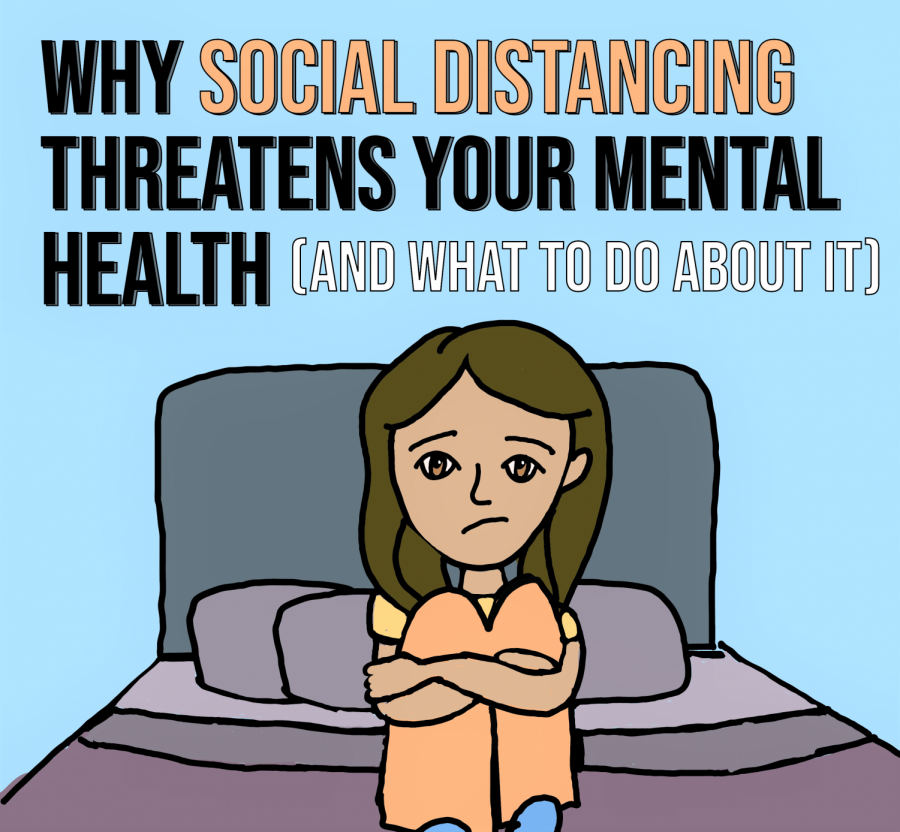Why Social Distancing Threatens Your Mental Health (And What to Do About It)
April 1, 2020
“Take care of yourself”: A phrase that, for obvious reasons, you’ve probably heard more in the last two weeks than in the past two years. With the coronavirus rapidly spreading, health, both mental and physical, is critically important. You’ve all heard to wash your hands and avoid touching your face, but maybe information about your emotional well-being was a little less clear.
I recently spoke with Dr. Jeffrey Ng, director of Counseling and Psychological Services for Fordham University at the Lincoln Center, Rose Hill and Westchester campuses. Here’s what I found out, as well as some ideas to help you cope with these strange times of adjustment and uncertainty.
Why does social distancing put mental health at risk in the first place?
Ng pointed to a few different reasons for this. Humans are innately social and relational and have evolved to be interdependent with one another for their survival and well-being, he said. Removing the physical aspect of our interdependence can be somewhat shocking.
Not only this, but Ng noted that the mandate for social distancing was out of our control. “There’s a sense of helplessness about it,” he said. “We did not willingly decide to maintain physical distance from each other. We were told we had to.”
Even though most of us understand and agree with the rationale for social distancing, some college students may struggle with being told what they can or cannot do since autonomy and independence are especially salient for adolescents and young adults.
He also mentioned the fact that for many, social distancing and quarantining could lead to decreased physical activity, an important aspect of mental health and emotional well-being.
Warning signs of deteriorating mental health (for you and people around you):
It’s important to be cognizant not only of your own mental health, but also that of others with whom you interact. Ng listed a few indicators of worsening mental health that he said are relevant even “outside of any pandemic.”
Persistent irritability, sadness, anger, anxiety and/or hopelessness, especially for several weeks, are signals that emotional and mental health may be worsening.
This is concerning if “it reflects a significant change from how (one) knows (oneself) to be” or if “it interferes with day-to-day functioning,” Ng said. He encouraged students to be mindful of how able they are to attend to basic needs such as sleeping, eating and hygiene.
It’s also crucial to be aware of thoughts about death, dying or self-harm. Ng recommended connecting oneself or others with professional help if thoughts such as these arise.
The most important thing to remember
I wanted to know if Ng could point to one key takeaway for students to keep in mind. “Practice being more self-compassionate,” Ng urged. “Be kinder and more patient with yourself. It’s probably not very realistic to expect to ‘stay on track,’ whatever that means” personally. One can’t hold oneself to the same productivity and efficiency standards as before the pandemic hit, he said.
“It’s critically important for us to acknowledge and lean into our feelings about all this, whether it’s sadness, or anger, or frustration — find ways to express it rather than ignoring, neglecting, or suppressing it,” Ng advised. Distracting ourselves from our feelings can be helpful at times, he said, but it’s essential to return to and process them when we’re ready.
He also wants students to figure out what works for them from a self-care perspective. “Every student is unique, and what might be optimal for one student might not be the best for another,” he said.
While some students may be ready to process their emotions about the social distancing situation, others may more readily seek distraction. Activities such as journaling, meditating or conversing with partners in isolation or with other friends and family over FaceTime can help to confront some of these new and burdensome feelings. Taking a walk outside or taking the time to learn a new hobby are other activities that may help to alleviate stress.
On that note, below are several ideas for things to do from the comfort of your own home during social distancing.
Activities to help process
When your life is turned upside down (as all of ours have been), it can be necessary to just slow down and think it through. Here are some ideas to help process your thoughts and emotions.
Have a spare notebook lying around somewhere? Write down how you feel. It might seem cliché, but getting your thoughts down on paper can greatly improve your emotional well-being. It doesn’t have to be in the format of a journal entry, try writing a song or a poem.
Talk to someone. If you’re tired of everyone in your isolation group, call, text or video chat a friend and talk it out. You’re not the only one going through this — chances are whoever you reach out to is in a similar boat. Social distancing does not mean social isolation, so maintaining connections with friends who now might be across the globe is equally as important as can be enjoyable.
Try meditation. Even short sessions of just a few minutes can help clear your head and realign your focus. Never tried it before and feel a little intimidated? Find a guided meditation on YouTube. The Internet is your oyster.
Activities to help distract
Sometimes, dwelling on your feelings just feels worse. Here are some ways to take your mind off of everything that’s going on. (Please do not engage in any activities that contradict rules set by your local government.)
Physical activity is key to staying emotionally healthy. If you’re able to get outside, go for a run, walk or bike ride. Got limited space? Find a guided at-home workout on YouTube, or create your own. With tons of indoor exercise resources out on the internet right now, try switching it up; find a yoga video today, follow an ab workout tomorrow.
Channel your creativity into art. Painting, drawing, or sculpting can be incredibly therapeutic. . Make a cool collage from old magazines and newspapers.
Learn a new skill. Dig out that old recorder from fourth grade music and (annoy your housemate)s. Try to cook something. Bake bread or recreate your favorite restaurant dish with whatever you’ve got on hand. Got a camera lying around? Figure out how to work it. Download Duolingo and learn an obscure language. Freak out your mom by only talking to her in said obscure language.
Interact with whomever you’re socially distancing with. This might sound obvious, but have you made a ridiculously complicated Rube Goldberg machine yet? How about some type of home video? Played every single board game in the basement? Every card game in your repertoire? Have a picnic if you have the yard space. Mix up the most disgusting concoction you can possibly think of from whatever’s in your pantry and see who chickens out first. Have a fashion show. Have a talent show. Have an art show. Have a concert. The possibilities are endless!
Clean. I hate to recommend this, but boredom drives me to new lengths. You’ve got the time. Go all in. Check out your attic or your basement. There’s definitely something cool in there that your parents never told you about. Some weird old photo album. Your great-great-grandma’s wedding veil. Your baby teeth. You never know.
Write a letter. Snail mail is exponentially more exciting (and meaningful) to write and receive. Write to that friend who used to live six floors down but is now living six hours ahead. It’ll get to them about three weeks later, but who doesn’t love a slow burn? And when you get the response next September, it’ll be a delightful surprise.
If you burn through all of these ideas, the Internet has many more ideas of activities you can do while practicing safe and responsible social distancing. If you or someone you know is struggling with mental health, please check out the resources below.
Resources
Counseling and Psychological Services is still providing services remotely. Ng also recommends the National Suicide Prevention Lifeline, which is available 24 hours a day at 1-800-237-8255, and the Crisis Text Line, which is available by texting HOME to 741741 in the U.S., to 686868 in Canada, and to 85258 in the U.K. Also, he encourages students to research additional resources specific to their localities.











